
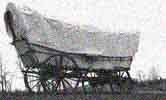
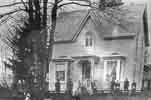
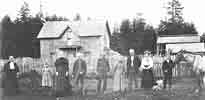
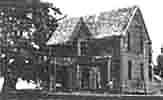
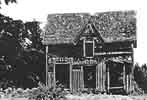
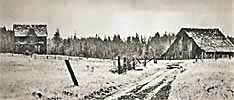
| Home |
| Early Life |
| Maps |
| Oregon
Laws |
| The
Trail |
| Bush
Biography |
| Tumwater
Born |
| Thurston
County |
| State
History |
| Bush
Farm Today |
| FAQs |
| Timeline |
|
George Washington Bush of Tumwater, Washington By Dr. Darrell Millner, Professor, Black Studies, Portland State University On November 6, 1845, after crossing the trail in 1844 and wintering along the Columbia River, five families and two bachelors, a total of thirty-one Americans in all settled in the Tumwater area. One of these settlers was named George Bush. His family included his wife, Isabella, and five sons. Why is George Bush of particular interest from this group of early settlers? There are several reasons. He was one of the most successful of the group, developing a farm that would be considered by his contemporaries as one of the most valuable and productive in early Washington. His personal qualities of humanity, generosity, hospitality, unselfishness, warmth, and charity led him to aid many later arrivals in ways that made their successful settlement possible, winning for him tremendous respect and admiration from the pioneer settler generation. His role in establishing the settlement north of the Columbia and the circumstances surrounding that decision and significant national and international political and diplomatic consequences can provide a useful window on the economic, social, and political realities of that era for us today. Finally, George Bush was a Black man. A free mulatto on the western frontier. As such he provides a dramatic counterpoint to the traditional all-Caucasian images of western development. This can be helpful in allowing our generation an opportunity to more clearly understand the true, complex multiracial reality of American expansion in the nineteenth century. In addition, his life assumes an even more remarkable magnitude in light of the additional obstacles and barriers based on race that George Bush overcame. The early years of his life are, for the modern student, shrouded in mysteries and uncertainties. For example, it is not known with certainty when George Bush was born or where. Oral family history provided by twentieth-century descendants, states his year of birth as 1779. A prominent pioneer contemporary, Francis Henry, listed it as 1778. But the 1850 federal census gives his birthplace as Pennsylvania and his age as seventy in that year, making his birth year 1790. Many historians consider this last date most reliable, perhaps because to accept the family version of 1779 would make Bush sixty-five when he started the journey across the trail in 1844, what some may consider an advanced and unlikely time of life to accomplish that difficult task and endure the hardships and hard work that the next two decades of establishing a frontier farm would have required. I personally favor that early family given date of 1779 for no particularly persuasive academic reason, but simply because the hint of the improbability it carries fits well and consistently with the other remarkable improbabilities that we know to be true about this remarkable life, and is thus to me a fitting beginning to that story. What else do we know of the early Bush years? It is believed that he spent his childhood in Pennsylvania, raised and educated under Quaker influence. Bush was a literate man but none of his writings have survived. As a young man he is believed to have located to Tennessee and then at about age twenty, relocated to Illinois where he entered the cattle business, an activity often associated with his success for the rest of his life and considered the source of his financial resources for the Oregon trip. About 1820 he is supposed to have relocated again to Missouri, the place from which he departed in 1844 to Oregon. There are few facts documented with certainty that can be fitted between the reference points on this sparse outline. He supposed to have gone to the Far West as a young man working in the fur trading industry, ranging as far west and north as Vancouver Island and as far south as the Santa Fe Trail where he is supposed to have known Kit Carson. Some descendants claim he worked for a time for the Hudson’s Bay Company. For none of this do we have specific documentation. Family sources also state that George had fought in the Black Hawk Indian War where he was wounded, and that he was a participant in the Battle of New Orleans under Andrew Jackson in 1815. We do know that on July 4, 1832, he married Isabella James, a white native of Tennessee, in Clay County, Missouri. This union eventually produced nine sons, five of whom made the trip across the trail in 1844, and was the source of much of the success, stability, and happiness of the next thirty years of the Bush story. Was George Bush Black? A key question in an era during which your race could be the single most important factor in determining your fate. This seemingly simple question becomes complex and even controversial as is often the case in Bush biography. Why? Race in American culture has never been a simple issue of biology; legal and cultural factors being at least as important. Little is known with certainty about the lives of Bush’s mother and father. Therefore, to sort out Bush’s racial status it is necessary to look at evidence both pro and con on the question of whether he was Black. There is some evidence he may not have been Black. It is well established that his mother was an Irish maid in the household of a merchant named Stevenson in Philadelphia in the late eighteenth century. Racially speaking, it is generally concluded that his father, Matthew Bush, was Black and had been born in India and brought to America sometime before 1776 by this merchant named Stevenson. There he married the Irish maid. George was their only child. Regarding Matthew’s “India” origins, it has been suggested by some scholars that he could have been from the “West Indies” rather than “East Indies,” given the large African-American population in the Caribbean, but this is only speculation supported by no documentation. It was suggested by a great-granddaughter, Mrs. Belle Twohy, when interviewed by Mr. Paul Thomas, a University of Washington graduate student in 1965, that Matthew Bush, having the dark skin of some from India, was mistakenly categorized as a “Negro” by Americans of his generation. This is in theory quite possible. A testament to the imprecision of racial identification in George’s era is the fact that in the 1830 Federal Census in Clay County, Missouri, where he was then resident, George Bush is listed as a “free white person.” There is however strong evidence that Bush was Black or specifically that he was a mulatto. Perhaps the most powerful evidence of his racial designation as Black is found in how his contemporaries considered and described him. The scant documentary and narrative evidence available is consistent in describing Bush as a mulatto. This includes a statement by a fellow member of the 1844 migration who knew Bush well, John Minto. Minto, who described a conversation he had on the trail with Bush in 1844 concerning the treatment of people of color in Oregon said, “Bush was a mulatto, but had means, and also a white woman for a wife, and a family of five children. Not many men of color left a slave state so well to do, and so generally respected.” A more indirect reference is made by Ezra Meeker, a trail pioneer who met Bush at Tumwater in 1853. Meeker observed: “George Bush doubtless left Missouri because of the virulent prejudices against his race in the community where he lived.” Further evidence that Bush was considered Black and treated as such by his contemporaries comes from the 1850s and involves the Homestead Act (Donation Land Act) that was passed for the Oregon Territory in 1850. It stipulated that only whites (males and married females) and “American half-breed Indians were eligible to receive free land in Oregon. Bush was so well liked and respected by his white fellow settlers that fifty-five of them asked the new Washington Territorial Legislature on March 1, 1854, to memorialize the U.S. Congress for an exemption for Bush to these provisions of the Land Act. It did so in these words: …the Legislative Assembly of the Territory of Washington…would most respectfully represent unto your honorable body, that George Bush, a free mulatto, with his wife and children, emigrated to, and settled in, now Washington Territory, Thurston County, in the year 1845….. On February 10, 1855, the U.S. Congress passed a special act granting Bush his land claim. Bush neither denied nor challenged his description as a mulatto in these proceedings. It is clear that whatever the biological origins of George Bush might have been, legally his contemporaries considered him as a Black man, which meant that he would have to surmount, in addition to the normal obstacles of frontier life, additional difficulties presented by racial conventions of the nineteenth century. When searching for the reason a man like Bush, evidently with some economic and material comfort, a commodious family life, and perhaps of an advanced age, would choose to tackle the Trail in 1844, his race may provide some insight. A descendant, Emma Belle Bush, told Paul Thomas in an interview in the 1960s, “I am not sure why George came west in 1844. As far as I know, he was having a hard time in Missouri. People would not sell him anything because they said he was a Negro. That is probably one reason why he wanted to leave there". She added that George was, “the roving type of person.” Taken together, these circumstances probably provided his main motivations. The trail outfit Bush assembled included six Conestoga wagons, equipped with enough provisions for a year (according to John Minto), he also helped provision two other families that made the trip, the Kindreds and Joneses. The train that these families joined was organized about the first of May 1844 about thirty miles west of St. Joseph, Missouri. It was commanded by Colonel Cornelius Gilliam, and organized into four “companies.” The Bush group was in the company of Captain R. W. Morrison. The trip itself was of course difficult, as they all were, but in the context of that experience, relatively uneventful. It took them seven months, the group arriving at the Dalles in December 1844. There the group split with most of the five families going on to Washougal where they stayed through the summer of 1845. George Bush and others wintered the livestock around the Dalles and brought it down to Washougal in the spring of 1845. Prior to 1845 the prime location of American influence and settlement in the Oregon Territory was in the Willamette Valley south of the Columbia River, with Oregon City as the focal point. When George Bush and the members of the Bush-Simmons party decided to settle at Tumwater, north of the Columbia, this was a significant departure from the normal pattern of American settlement. Some historians suggest that this decision has a large part to play in the eventual compromise and partition of old Oregon Territory that created the modern Canadian border and gained possession for America of the present-day state of Washington. The presidential election of James Polk in 1844 with his “Fifty-four-forty or Fight” slogan, reflecting the strong desire by many Americans to acquire all of the Oregon Territory provided the national political backdrop of these events. But it is also true that more local and personal motives and events were a part of that fateful decision to settle north of the Columbia. For George Bush, a free mulatto, traveling west at least in part to escape the stifling racial discriminations of the slave state of Missouri, racial factors were an unavoidable consideration. In June 1844, only months before the arrival of Bush into Oregon, the provisional government there had adopted, at the invitation of another Missourian named Peter Burnett (who had made the migration in 1843), a Black Exclusion Law making it illegal for a Black person to settle in the Oregon Territory. Punishment for violation of this act was set at thirty-nine lashes delivered in a public whipping, repeatable every six months until the Black departed. Fellow pioneer John Minto recalled a conversation while on the trail in which Bush revealed his apprehensions about what awaited him in Oregon regarding racial matters. “He told me he should watch, when we got to Oregon, what usage was awarded to people of color, and if he could not have a free man’s rights he would seek the protection of the Mexican government in California or New Mexico.” When Bush was confronted by Burnett’s exclusion upon arrival he was indeed a man torn by an ironic dilemma. To achieve personal racial security ha had to avoid American-controlled portions of Oregon. In 1845 that could be done by settling in the more tolerant regions of English control or by proceeding south into Spanish territory. In the case of going onto the English regions such settlement itself might be self-defeating by contributing to the American acquisition of that area in the contest between England and America for the ownership of Oregon. Eventually that could bring him once again under jurisdiction and oppression of American racial dispositions. Bush eventually chose the Tumwater option. We can only imagine the agonies and uneasiness that choice must have entailed. What was life like on the Tumwater frontier? What were the conditions at the early settlement? The first difficulty was getting there. To do so it was first necessary to go up the Columbia River by boat from Fort Vancouver, then up the Cowlitz River, and then walk overland on mere foot trails. The approximately sixty-mile trip took about fifteen days. The first years were very hard. They arrived with only the material they could tie on their pack animals or carry themselves. The land was heavily forested and there were no roads and little open ground. They had only very crude tools to clear the land for crops and to construct shelters. In addition, they arrived right at the onset of winter. According to Paul Thomas, the first homes were “crudely constructed shelters made of split logs” with bare earth floors, no windows and wooden “shake” roofs. The beds were made of either planks or stretched animal skins and could accommodate four or five people. Reportedly, more than one family shared a cabin during that first winter. In the early years the settlers had five essential sources of food:
What did they obtain with this credit initially? Records indicate that “with it they obtained 200 bushels of wheat, 100 bushels of peas, 300 bushels of potatoes, and ten head of cattle.” This constituted the main elements of their diet in that first winter. Records also indicate that the only member of the original settlers that did not draw upon this letter of credit from McLoughlin was the Bush family. This may indicate that Bush had been able to pay cash for his needs and was therefore somewhat better off than the other families at that time. Food from the local Indian population and native traditions were also important in those early years. Use of “seafood” like oysters, clams, salmon, etc., came from native sources. The settlers also acknowledged that it was the native population from which they learned what they could eat from the forests, things like fern roots, lackamas, and other plants. The settlers also hunted for food. Game included deer, elk, bear, and waterfowl like ducks, geese, etc. Eventually they grew crops. Their first crops were wheat, peas, and potatoes, but the first yields were very small and most of it had to be saved for the next years planting. One of the early settlers, Sarah McAllister, recalled that it was nearly three years before they had bread from the wheat of their own land. But by 1850 the settlers had established themselves and Bush’s farm was prospering. By that year his farm produced large crops of wheat, rye, oats, potatoes, and hops; he also turned out large quantities of wool and butter. An especially crucial and difficult problem for all the settlers was acquisition of domestic animals for their farms. For the Bush family the process was a slow accumulation of the necessary stock from a wide variety of sources under difficult circumstances over a number of years. In 1846 George took two weeks to ride to Cowlitz Prairie and return with a hen and a setting of eggs from Simon Plamondon, a friend and a former French Canadian Hudson’s Bay Company employee. Mrs. Bush, through hard work and personal diplomacy, was the source of the family turkey flock and their first sheep stock acquired from the holdings of the Hudson’s Bay Company at Fort Nisqually. By 1850, the farm held over one hundred horses, cattle, sheep, pigs, and ten oxen all together valued at over $2,000. But once acquired and accumulated the difficulties with stock did not necessarily end. The protection and preservation of domestic stock in a frontier environment was an ongoing challenge. The dangers included theft from any variety of sources as well as potential predation from the still numerous wild animals in the area, e.g., bears and cougars. Bush family tradition tells of a 200-pound cougar or “tiger” as the boys called it, that they killed on the farm in the 1850s, after it had killed one of their ponies. The settlers also had difficulties in acquiring the other amenities of “civilized” life and the other necessities of successful settlement. Lewis, the youngest son, was about twelve years old before he had his first pair of shoes. Presumably he wore Indian-style footwear or went barefoot before that age. There were other difficulties and concerns that kept frontier farming life challenging and unpredictable. Weather for example could be as great a barrier to success or even survival as any factor on the frontier. Disease was a constant threat and danger to the settlers and natives alike. The Tumwater enclave faced a measles epidemic in the winter of 1847-48, and an outbreak of smallpox in 1853. What also emerged over the early years as a significant concern was the relationship between the incoming American settlers and the resident native population. The Indians had been on generally good terms with Hudson’s Bay Company for years. The relatively small number of early American settlers, like the Bush-Simmons group of 1845, did not seriously upset this equilibrium. This is not to say that relations with the Indians were always smooth or that serious elements of danger did not exist in this relationship in the early years. Sanford Bush, for example, recalled one occasion when two warring local tribes numbering in the hundreds, fought all day against each other on the Bush farm but both sides refrained from attacking the settlers. But by the 1850s, greater strains had begun to appear in the Indian/settler relationship due most to the pressures created by the increased number of settlers occupying more and more land and thus taking it out of traditional Indian uses. This culminated in the Indian War which broke out in 1855-56. The Bush clan suffered no casualties during these difficulties, and in general, the early settlers were sympathetic to the many legitimate grievances held by the Indians. Nonetheless, it was not a time or place where normal agricultural pursuits could be followed, and frontier farm life in the area was seriously disrupted. At one time the Bushes and their neighbors constructed a fort on the Bush homestead for protection. The conclusion of the war doomed the traditional lifestyle of the local tribes and opened the way for further settler development. Bush’s property continued to grow with the years. By 1860 his holdings had grown to 880 well-cultivated acres, making it one of the larger and more prosperous farms in Thurston County and the Oregon Territory. Life at Bush Prairie was not all danger and hard work. There were dances, parties, picnics, holiday celebrations, and other joyful events to spice up the social life of the frontier settlement. The Bush homestead became famous for its hospitality and generosity of treatment to travelers, strangers, visitors, and any local in need of a hot meal or a warm bed. If success can be said to be the possession of material comfort, economic security, and the love and respect of your family, neighbors, and contemporaries, then George Bush was a most successful pioneer. Just as he had done in overcoming the physical, emotional and environmental challenges presented by the trail and the western farming frontier, George Bush was able to defeat the additional societal impediments that his race created. One of the most effective influences in his ability to do so was the nature of his personality and the great humanity of his character. In the Washington memorial to Congress seeking a land exemption for Bush in 1854, this testament to both qualities appeared: “...he has contributed much towards the settlement of this territory, the suffering and needy never having applied to him in vain for succor and assistance..." This language is a reference to the great generosity provided by Bush to later arriving immigrants to the territory. The trail experience typically drained not only the physical and emotional resources of the emigrants, but it drained their economic resources as well. Most arrived at the end of the trail little able to afford or self-supply the requirements of survival over the first unusually hard winter. Nor did many possess the necessities for getting in the all important first crops the next spring. For many settlers in the Washington area, their success had depended on George Bush. Ezra Meeker described his remarkable unselfishness in these words concerning Bush’s behavior in 1852-53 when the numbers of new immigrants combined with a small local harvest that year created a dangerous food crisis: “…the man divided out nearly his whole crop to new settlers who came with or without money… `pay me in kind next year,` he would say to those in need, and to those who had money, he would say `don’t take too much… just enough to do you` and in this wise divided his large crop and became a benefactor to the whole community.” This greatness of spirit is a true measure of a remarkable man and a fine soul. George Bush died April 5, 1863, of a cerebral hemorrhage on the farm at Bush Prairie. At the time of his death, the country to which he helped add a valuable possession and to whose advantage his wide-ranging activities in the fur trade and on the pioneer frontier contributed, was consumed by a great internal military conflict that would revise dramatically the place and the role of his race within its embrace. He did live to witness the historic issuance by Lincoln of the Emancipation Proclamation in January 1863, although he had passed from this realm before the Civil War was ended and a new era of American race relations began. It is not hard to imagine the satisfaction George Bush must have felt at that time in his life as he could look both back upon the wondrous role he had played in the seminal events of the nineteenth-century expansion, and look forward to what new challenges and opportunities the coming generations would offer his sons and his race. It is not hard to appreciate the benefits to our own generation that the presence of a man with the ability, character, and humanity of a George Bush would create as we struggle to continue our national evolution on the racial frontiers of today. Another view of this article taken from the Columbia Magazine - Winter 1994-95 - Washington State Historical Sociey |